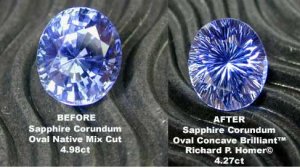katbadness
Shiny_Rock
- Joined
- Jan 29, 2004
- Messages
- 480
Inquiring mind wants to know more...

On this thread on the Rocky Talk forum, Rich Sherwood said:
"Light return performance is largely determined by the relationship of the crown angle to the pavilion angle."
Now, I'm assuming that the same principle applies for colored gems, as well. However, I'm also assuming there are other things that's involved in determining how a colored gem rough is cut.
I posted my 2 cents of what I understand about colored gem cutting on the tanzanite thread.
But now I'm *really* curious...
What are the other factors involved (other than light/dark of body color of a rough)? How does a cutter determine how to best use the rough to obtain best looking gem?
One thing of a particular interest for me, is there such a thing as an interplay between the refractive index and the angle by which the cut is angled to obtain the most optimum cut for the material? Or am I not understanding what I was explained correctly?

(Hmmm... this probably warrants me looking into learning how to cut gems!!
 )
)

On this thread on the Rocky Talk forum, Rich Sherwood said:
"Light return performance is largely determined by the relationship of the crown angle to the pavilion angle."
Now, I'm assuming that the same principle applies for colored gems, as well. However, I'm also assuming there are other things that's involved in determining how a colored gem rough is cut.
I posted my 2 cents of what I understand about colored gem cutting on the tanzanite thread.
But now I'm *really* curious...
What are the other factors involved (other than light/dark of body color of a rough)? How does a cutter determine how to best use the rough to obtain best looking gem?
One thing of a particular interest for me, is there such a thing as an interplay between the refractive index and the angle by which the cut is angled to obtain the most optimum cut for the material? Or am I not understanding what I was explained correctly?

(Hmmm... this probably warrants me looking into learning how to cut gems!!















300x240.png)